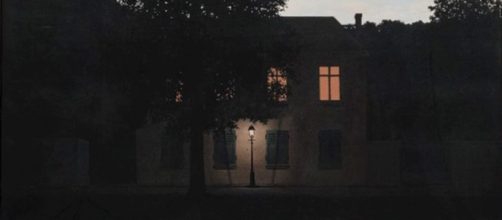Hyperbole and high art go together like Dali and melting watches. Modeling this point is the opinion of Connoisseur magazine that a painting by Surrealist Rene Magritte, heading for Sotheby’s auction block in London next month, is “one of the most desirable works of modern art in private hands.”
The basis for that claim is unclear, but a bona fide claim can be made for this painting titled "L’empire des lumieres" (Empire of Light). Magritte’s vision was the inspiration for what became an iconic scene in William Friedkin’s 1973 movie “The Exorcist.”
Help is on the way
You may remember that haunting night scene in “The Exorcist” when the priest, Father Merrin played by Max von Sydow, is silhouetted under a streetlamp.
You can see his fedora and briefcase outlined by the light as he approaches the house where a demonized girl awaits his help.
The novel by Peter Blatty on which "The Exorcist" was based, describes the same scene of Von Sydow standing outside the house of the ailing girl “like a melancholy traveler frozen in time.” The intensity of the scene is so vivid, it became the poster for the movie.
Magritte’s painting, while a vision of meticulously rendered realism, turned Surreal when he painted the sky in the night scene with the brightness of day. Placing disparate things in the same pictures is vintage.
Films, fiction, and fine art teamed up again in the 2003 movie “Girl with a Pearl Earring.” The title of Johannes Vermeer’s 1665 painting became the title of the tale told by Tracy Chevalier’s 1999 novel of the same name.
The Dutch Mona Lisa
Closely following the novel, the movie shows the servant girl Grier modeling for Vermeer wearing Mrs. Vermeer’s earrings. Known as the Dutch Mona Lisa, the portrait can be viewed either as smiling or sad, and it’s not clear which.
Scarlett Johansson plays Grier taking an interest in artmaking with a kind of sensual awakening that moves Vermeer. Her portrayal may also be seen as a sexual awakening as her attraction to the painter grows.
More mixed media of fiction, film, and fine art can be seen in the 1981 movie “Pennies from Heaven” directed by Herbert Ross and the painting Nighthawks by Edward Hopper.
The good old days
Ross’s movie, set in the Great Depression, is probably the saddest of any musical ever made.
And to drive home the oppressiveness of the time, he emphasizes that grim reality by setting it all to the tune of happy songs from the ‘30s.
This movie gets all the sadder when the Depression characters imagine themselves in elaborate Hollywood stage productions of song and dance.
“Pennies from Heaven” is so cheerless that it’s not surprising that Ross chose to recreation Hopper’s gloomy Nighthawks down to the lack of connection between the two seated men and woman next to them.
You see the same people in Hopper's painting of a handful of diners hunched over a diner counter late at night. The painting is universally understood as a portrait of alienation in modern America. Ross opted to tie that alienation to the Great Depression.
Relating film to fiction to fine art even makes Hollywood look good.


